


Vassily Ivanchuk – Sergey Karjakin
Amber-rapid 17th Nice (4), 18.03.2008
It was a hard task to select my favourite game of Vassily Ivanchuk. Indeed, we are talking about a legend, who has produced hundreds of masterpieces in all aspects of chess. After a long and difficult reflexion, I've chosen this one.
1.e4 c5 2.Nf3 d6 3.d4 cxd4 4.Nxd4 Nf6 5.Nc3 a6 6.Bc4 The Sozin Attack usually leads to complex positions, as the bishop exerts pressure on the kingside, and White can continue with f2–f4–f5 or to consider thematic sacrifices on e6 sometimes.
6...e6 7.Bb3 b5 Karjakin chooses the main line.
7...Nbd7 is another option, trying to get rid of White's dangerous bishop as soon as possible, in order to avoid the aforementioned attacking ideas.
8.Bg5
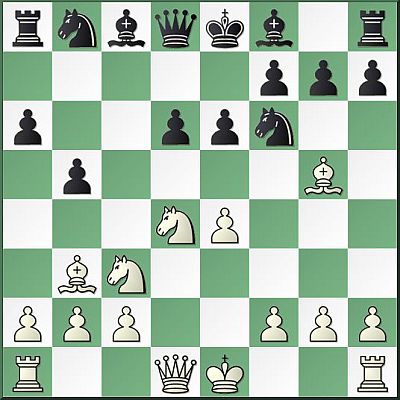
Ivanchuk prioritizes quick development and looks for an aggressive set-up.
8.0–0 is the main line.
8...Be7 9.Qf3! Developing with tempo thanks to the "subtle" threat of e4–e5.
9...Qc7 9...Bb7? allows White to show one of the typical motifs in this line: 10.Bxe6! fxe6 11.Nxe6 Qd7 12.Nxg7+ Kf7 13.Nf5+– with three pawns and a winning attack for the sacrificed piece. But 9...Qb6 is also possible.
10.e5!? Again Ivanchuk deviates from the most played path, yet his decision is totally logical: White is ahead in development and tries to exploit that by energetic play.
10.0–0–0 is the most played.
10...Bb7 11.exd6 Bxd6 12.Qe3 The pressure on e6 looks already very serious and Black has to think about it.
12...Bc5! Black temporarily avoids the sacrifice.
12...Be5 is another option, but the bishop is not safe on e5: 13.0–0–0 Nbd7 White has 14.f4!? (My engine says that 14.Nxe6! fxe6 15.f4 is even stronger.) 14...Bxd4 15.Rxd4 0–0 16.f5!? exf5 17.Rhd1 Rae8 18.Qh3 and White has a strong initiative.
13.0–0–0 Nc6 My favourite moment in this game has arrived. Try to guess Ivanchuk's next move.
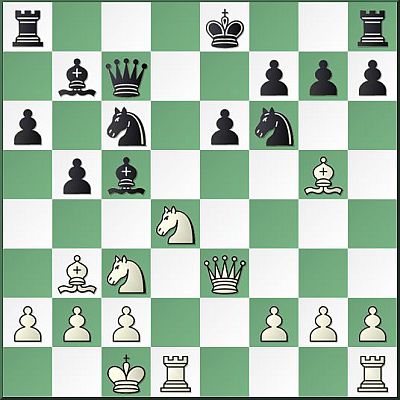
14.Qxe6+!! Although sacrifices on e6 are very common in this line, I really doubt that anyone seeing this game for the first time would imagine that the piece chosen by White to destroy Black's defenses in the centre would be his queen! Still, geniuses like Ivanchuk are made by beautiful and shocking decisions like this. Also, this was a theoretical novelty at the time the game was played.
14...fxe6 15.Nxe6 Let's take a moment to understand the picture: White has sacrificed his queen for two(!!) pawns, but in return he has destroyed the protection of Black's king and has almost all his pieces ready to attack it in the centre. The word "almost" is of course because White is one move away of full activation with Rhe1, in which case we can fairly assume that not even the queen will be able to prevent Black from being mated. Still, nobody had thought this way before Ivanchuk! As a Najdorf player myself I had to carefully study this position, and trust me: Black should not underestimate White's attacking chances here.
15...Qe5 Of course, in a rapid game it is much easier to go wrong when facing unexpected problems.
15...Qe7 seems the best way to solve Black's problems: 16.Nd5!? Nd4! (16...Nxd5 is also possible, but the game remains complicated after 17.Bxe7 Ncxe7 18.Nxc5 0–0–0 19.Rhe1) 17.Nxe7 Nxe6 18.Bxf6 Bxe7 19.Bxe7 Kxe7 20.Rhe1 Bc8 Black is about to consolidate his position by bringing the rooks into play, so White should try 21.Rxe6+! Bxe6 22.Re1 but after 22...Rhe8! with a slight advantage for Black. Black keeps the best chances in the endgame, despite the material balance. Still, besides the short time control to calculate and to avaliate such lines, I imagine it should be a very difficult situation from a psychologic aspect to give back the queen that your opponent has sacrificed a few moves ago for only two pawns.

16.Nxg7+! 16.Rhe1 allows 16...Qxe6! transposing to 15...Qe7.
16...Kf8 16...Ke7? 17.Rhe1 Qxe1 18.Rxe1+ Kd7 19.Bxf6 is much better for White.
17.Ne6+ Kf7! Even under unpleasant pressure, Karjakin finds the best way to fight.
After 17...Ke7 the king remains exposed in the centre, as we can see in the line 18.Rhe1 Bxf2! 19.Rxe5 Nxe5 20.Ng7! Neg4 21.Nf5+ Ke8 22.Nd6+ Kf8 23.Nxb7 and Black still faces problems, for example: 23...Be3+ 24.Bxe3 Nxe3 25.Re1 Nxg2 26.Rf1 Ke7 27.Rg1! Nf4 28.Rg7+ Ke8 29.Nd6+ Kd8 30.Nf7++–; 17...Ke8?! has similar problems: 18.Rhe1 Qxg5+ 19.Nxg5+ Be7 20.Nf7; Returning the queen is a bad idea now: 17...Qxe6? 18.Bxe6 White keeps a dangerous attack.
18.Rhe1 Qxe1? Perhaps time pressure was a problem at this point, but when White brings his last soldier to the battlefield, Karjakin cracks under the pressure.
18...Qxg5+!? was a better try, but White keeps the initiative after 19.Nxg5+ Kg6 20.Nce4 Be7 21.Ne6!; 18...Bxf2! was the right move: 19.Rxe5 Nxe5 20.Nd8+! Kg6 21.Bxf6 Kxf6 22.Nxb7 White has two pawns for the exchange and is able to exploit the still exposed position of the king with his pieces. Nevertheless, with correct play Black should be able to avoid the dangers and to keep the fight.
19.Nxc5+ Now White keeps three pawns and very active play for the exchange, with obvious advantage.
19...Kg6 20.Rxe1 Kxg5 21.Nxb7 Nd4 22.Nd6 After brilliant play in the opening, Ivanchuk displays excellent technique to convert his advantage in this endgame.
22...Rhf8 23.f3 b4 24.Nce4+ Nxe4 25.Rxe4 Nxb3+ 26.axb3 a5 27.Rg4+ Kf6 28.Ne4+ Ke5 29.Rh4 a4!? 30.bxa4! White only needs to be a bit careful.
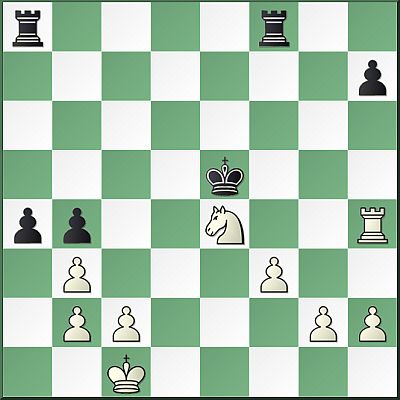
After 30.Nf2? axb3 31.cxb3 Rfd8! could give some chances of surviving for Black.
30...Rxa4 31.Nc5 Ra1+ 32.Kd2 Rg8 33.g3 Rf1 34.Ke2 Rb1 35.Rxb4+– Too many pawns, White is winning. The rest is simple.
35...Kd5 36.Ne4 Kc6 37.h4 Rh1 38.Rc4+ Kb6 39.b4 Rd8 40.Rc5 Ra8 41.c3 Ra2+ 42.Ke3 Re1+ 43.Kf4 Rf1 44.Rh5 Ra8 45.Rh6+ Kb5 46.Nd6+ Ka4 47.Rxh7 Kb3 48.Rc7 Rd8 49.Nf5 Hopefully you have enjoyed this beautiful game as much as me. Ivanchuk's creativity still amazes me, even after seeing it many times.
1–0
Vassily Ivanchuk - Li Chao Bo
Gibraltar Masters 12th Caleta (6), 02.02.2014
Grandmaster Ivanchuk played great chess in the Gibraltar Open 2014, demonstrating a very high level. He duly shared first place with the best performance. Alas, the tie-break regulations in that year were far from perfect.There was a three-way tie for the 1st place and a drawing of lots determined that the two most successful players in the tournament (both in terms of play and performance) had to cross swords to challenge the third-ranked player who could relax or prepare in the meantime. (That said, I am not going to belittle the result of the eventual winner, a very strong grandmaster who he has understandably also played very well in the classical part and won the final tie-break with a very strong play.) In the following years, the organizers improved the tie-break regulations to avoid such cases.
1.e4 c5 2.Nf3 d6 3.d4 cxd4 4.Nxd4 Nf6 5.Nc3 Nc6 6.Bc4 Grandmaster Ivanchuk is an universal player who can play well almost any opening. Here he choses a classical line.
The alternative 6.Bg5 has been the most popular option, but the Chinese grandmaster had undoubtedly prepared for it.
6...Bd7 7.0–0 e6 Black could also play 7...g6 , as white's setup is not the most challenging one against the Dragon.
8.Bb3 Be7
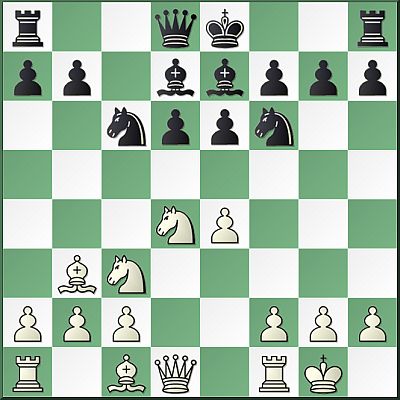
9.f4 White players usually prepared this advance with 9.Be3 or 9.Kh1, but the Ukrainian grandmaster chooses a more straightforward option.
9...Nxd4 After 9...0–0 white could try 10.f5!? (, while 10.Be3 Nxd4 11.Bxd4 Bc6= transposes to normal lines.)
10.Qxd4 0–0 Black could also swap the queens with 10...Qb6!? . After 11.Qxb6 axb6 12.Be3 b5 13.a3 Bc6 White cannot attack the b5, as his bishop is operating on a different diagonal. Even 14.f5 e5= does not distort the balance, either. White is not in time to occupy the d5–square and he should seek for compensation after 15.Rad1 Nxe4 (15...Rc8!?) 16.Nxe4 Bxe4 17.Bd5= .
11.f5

White immediately attacks the pawn e6. The e6–e5 advance would seriously weaken the d5–square. The drawback of this advance consists in the weakening of the e5–square.
Black's position would be very solid after 11.e5 Ne8 (and even a pawn sacrifice 11...Ng4!? deserves serious attention, as 12.exd6?! (12.h3! Nh6 13.g4 might be the critical continuation, restricting Black's knight while weakening White's king.) 12...Bf6 gives Black a lot of play along the diagonals a1–h8 and a7–g1.)
11...Ng4 This is a logical and ambitious reaction, the knight strives for the e5–square. Moreover, Black is threatening 12...Bf6, as 13.Qxd6? Be5 is not an option for White.
Leela suggests 11...exf5!? 12.exf5 Bc6= , but weakening the squares d5 and f7 might look counterintuitive. That said, I encountered such an idea in a similar position in Navara,D. - Anagnostopoulos,D., Czech Open Pardubice 1998 and the exchange on f5 followed by Bd7–c6 had undoubtedly been played before as well.
12.fxe6 Perhaps White could try 12.h3 , when 12...Ne5?! (After 12...Bf6! 13.Qxd6 Be5 14.Qd2! Black can no longer take a pawn on h2. Still, 14...Qh4!? 15.Qxd7 (Not the most practical continuation, but one which needs to be checked. (After 15.Qg5 Bd4+! 16.Kh1 Nf2+ 17.Kh2 Be5+ 18.Kg1 Qxg5 19.Bxg5 Bxc3! 20.Rxf2 Bd4 21.Rd1 Bxf2+ 22.Kxf2 Bc6 23.fxe6 fxe6+ 24.Ke3 the complications result in dynamic equilibrium.) 15...Qg3! 16.hxg4 Rad8 might result in a perpetual check unless White allows mate. Missing the check on d4 would lead to that.) 13.Bf4 Nc6 14.Qe3 exf5?! 15.Rad1 fxe4 16.Nxe4 would allow him to regain the pawn under favourable conditions.
12...fxe6 Black could play 12...Bxe6! 13.Bf4 Bf6!= , when 14.Qxd6? (14.Qd2!=) fails to 14...Bxb3 15.axb3 Bd4+ 16.Kh1 Nf2+ 17.Rxf2 Bxf2.
13.Bf4 Qc7 14.Rad1

Both Black's central pawns are vulnerable, but White's king is not completely safe, either.
14...Ne5 It is very hard to find and choose 14...Kh8! 15.Bxd6 e5! 16.Bxc7 (16.Qb4? would lead to heavy material losses after 16...a5!! 17.Bxc7 axb4 because of White's weak back rank.) 16...exd4 17.Nd5 Bc5.
15.Bg3 White could not play 15.Bxe5?! dxe5 16.Rxf8+ Rxf8 17.Qxd7?? Qxd7 18.Rxd7 Bc5+ 19.Kh1 Rf1#; , but 15.h3!?, removing the back rank threats, was worth attention.
15...Kh8? This move is logical but wrong.
While White's position looks more pleasant after 15...Rxf1+ 16.Rxf1 , Black should equalize after 16...a6= (or even 16...Bf6!? 17.Kh1 Nf7= , when 18.e5! Bxe5! 19.Qf2 Rf8 20.Bxe5 dxe5 21.Qxa7 Nd6 22.Rxf8+ Kxf8 brings White nothing special, as his bishop is slightly out of play.)
16.Rxf8+ Rxf8 17.Qxa7 The Chinese grandmaster had undoubtedly foreseen this, but might have overestimated his counterplay.
17...d5

Leela seeks counterplay after 17...h5! 18.h3 h4 19.Bh2 Bg5 , but the compensation looks very dubious after 20.Kh1!. Moreover, Leela did not exist back in 2014.
18.Kh1! Otherwise Black's position would be alright.
18...Bd6 White's last move has prevented 18...Bc5? , as 19.Bxe5 would have won a piece. Black cannot trap white's queen, e.g. 19...Qc8 20.Qa5 b6 21.Qa7+– .
19.exd5 Simple and strong.
White could also play 19.h3!?, when 19...Nf3 20.Qa3! (as pointed out by an engine) is truly brilliant, but few mortals would be able to find this move and evaluate it properly. 20...e5 (20...Bxa3 21.Bxc7 Bxb2 22.exd5 Bxc3 23.dxe6 Bxe6 24.Bxe6 with a technically winning position.) 21.Nxd5 Qb8 22.Qa5 Ng5 23.Bh4! (23.Nc3 Bxh3! is less clear, as Black's queen can enter c8 and the kingside.) 23...Nxe4 24.Qe1 Nc5 25.Nb6+– White maintains the extra pawn and restores the piece coordination.
19...Ng4 20.Qd4!
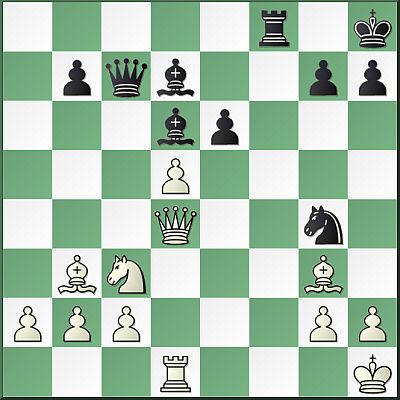
e5 Even the computer suggestion 20...h5! does not help. After 21.Ne4! Bxg3 22.hxg3 exd5 23.Qxd5 Bf5 24.Re1! Black cannot play 24...Bxe4? in view of 25.Qxh5+ .; 20...Bxg3? 21.Qxg4+–
21.Qd3! White keeps the e4–square vacant for the knight.
Less clear would be 21.Qe4 Qb6. Or perhaps just less precise?
21...e4! This is the best practical chance, but GM Ivanchuk found an elegant refutation of Black's concept.
21...Bf5 22.Qe2+–
22.Nxe4 Bxg3 23.Qxg3 Black would deliver checkmate on h2 after 23.hxg3?? Qe5 .
23...Qf4! Black creates a mating threat 24...Qf1+ and at the same time attacks White's knight, preparing a fork on f2. I like the games where both sides demonstrate good chess and interesting ideas, which is the reason why I decided to annotate exactly this game.
24.Qxf4 Rxf4
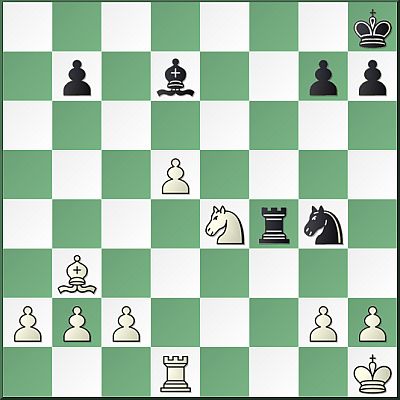
25.h3! An important intermediate move.
A dynamically balanced endgame would arise from 25.Re1? Rxe4 26.Rxe4 Nf2+.
25...Ne3 26.Rd4 White is allegedly winning even after 26.Re1?! Rxe4 27.Kg1 Re8 28.Kf2 Nf5 29.Rxe8+ Bxe8 30.c4, but it looks far from clear to me.
26...Nf5 27.Rb4 Rxe4 The alternative 27...b5 28.Kh2 Nd6 is no better, as white wins easily, playing 29.Nxd6 Rxb4 30.Nf7+! Kg8 31.Ne5+–. The d-pawn is hard to stop.
28.Rxb7! Black eventually won the knight, but paid a price for it. The four connected passed pawns cannot be stopped.
28...h5! Li Chao is a very strong and resourceful player, but this time it did not suffice.
The passed pawns would march forward after 28...Be8 29.Rb8!+– (or even 29.c4+– . Therefore Black tries a cunning trap. The Ukrainian legend was short of time, but reacted well.)
29.g4! With this move White distorts a mating net.
Black would even win after 29.Rxd7?? Re1+! 30.Kh2 h4, as the threat of 31...Ng3 could not be adequately parried, e.g. 31.g4 hxg3+ 32.Kg2 Re2+ 33.Kg1 Ne3–+ with a mate on the back rank.
29...hxg4 30.hxg4 Bc8 31.Rc7 Re1+ 32.Kh2 Re2+ 33.Kg1 Nd6 34.Rc6! Bxg4 35.Rxd6+– The game is over. Even in chess four is more than one. Black continued till move 40.
35...Kh7 36.Bc4 White activates the bishop.
36...Rd2 37.Bd3+ Kg8 38.Rg6 Bh3 39.b4 Kf7 40.b5 Rd1+ White would promote his b-pawn after 40...Rxd3 41.cxd3 Kxg6 42.b6 Bc8 43.d6! Kf7 44.d7 Bxd7 45.b7, but one check does not change anything.
41.Kf2 The time trouble is over, and so is the game. Grandmaster Ivanchuk played it superbly.
1–0
ChessBase Magazine #201 (May/June) offers 20 more annotated fantastic games by Ivanchuk - and much more!

Single issue: 19.95 € – annual subscription (6 issues) 99.70 €
Available for download (including booklet in pdf) or on DVD + booklet (Post).
| Advertising |